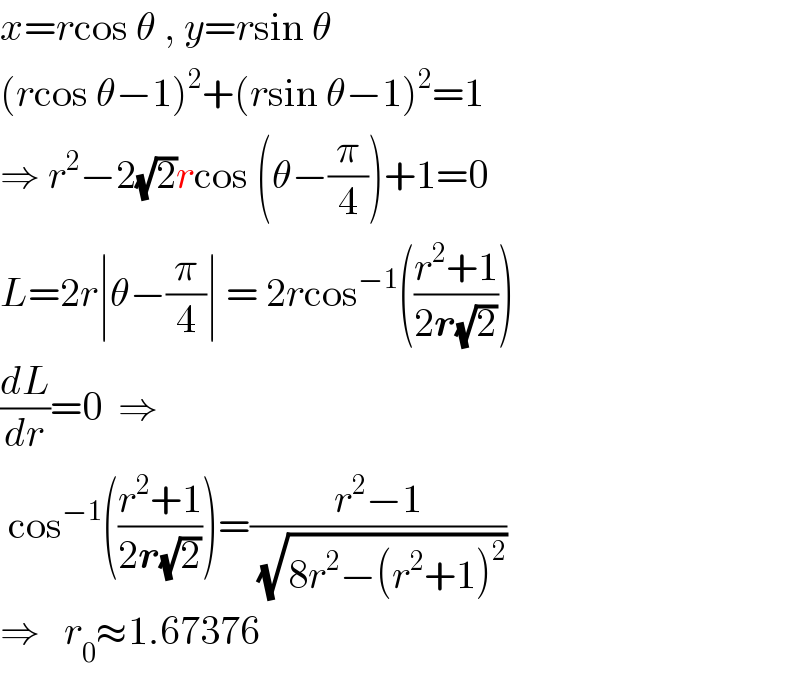
Question Number 65367 by ajfour last updated on 29/Jul/19

Commented by ajfour last updated on 29/Jul/19

$$\mathrm{For}\:\mathrm{maximum}\:\mathrm{arc}\:\mathrm{length}\:\mathrm{of}\:\mathrm{an} \\ $$$$\mathrm{origin}\:\mathrm{centered}\:\mathrm{circle}\:\mathrm{within} \\ $$$$\mathrm{the}\:\mathrm{shown}\:\mathrm{unit}\:\mathrm{circle},\:\mathrm{what}\:\mathrm{is} \\ $$$$\mathrm{the}\:\mathrm{radius}\:\mathrm{of}\:\mathrm{the}\:\mathrm{circle}. \\ $$
Answered by ajfour last updated on 29/Jul/19

$${x}={r}\mathrm{cos}\:\theta\:,\:{y}={r}\mathrm{sin}\:\theta \\ $$$$\left({r}\mathrm{cos}\:\theta−\mathrm{1}\right)^{\mathrm{2}} +\left({r}\mathrm{sin}\:\theta−\mathrm{1}\right)^{\mathrm{2}} =\mathrm{1} \\ $$$$\Rightarrow\:{r}^{\mathrm{2}} −\mathrm{2}\sqrt{\mathrm{2}}{r}\mathrm{cos}\:\left(\theta−\frac{\pi}{\mathrm{4}}\right)+\mathrm{1}=\mathrm{0} \\ $$$${L}=\mathrm{2}{r}\mid\theta−\frac{\pi}{\mathrm{4}}\mid\:=\:\mathrm{2}{r}\mathrm{cos}^{−\mathrm{1}} \left(\frac{{r}^{\mathrm{2}} +\mathrm{1}}{\mathrm{2}\boldsymbol{{r}}\sqrt{\mathrm{2}}}\right) \\ $$$$\frac{{dL}}{{dr}}=\mathrm{0}\:\:\Rightarrow \\ $$$$\:\mathrm{cos}^{−\mathrm{1}} \left(\frac{{r}^{\mathrm{2}} +\mathrm{1}}{\mathrm{2}\boldsymbol{{r}}\sqrt{\mathrm{2}}}\right)=\frac{{r}^{\mathrm{2}} −\mathrm{1}}{\sqrt{\mathrm{8}{r}^{\mathrm{2}} −\left({r}^{\mathrm{2}} +\mathrm{1}\right)^{\mathrm{2}} }} \\ $$$$\Rightarrow\:\:\:{r}_{\mathrm{0}} \approx\mathrm{1}.\mathrm{67376} \\ $$
Answered by mr W last updated on 29/Jul/19

$${lower}\:{intersection}\:{point}\:{P}: \\ $$$${x}_{{P}} ={r}\:\mathrm{cos}\:\alpha \\ $$$${y}_{{P}} ={r}\:\mathrm{sin}\:\alpha \\ $$$$\left({r}\:\mathrm{cos}\:\alpha−\mathrm{1}\right)^{\mathrm{2}} +\left({r}\:\mathrm{sin}\:\alpha−\mathrm{1}\right)^{\mathrm{2}} =\mathrm{1} \\ $$$${r}^{\mathrm{2}} −\mathrm{2}{r}\left(\mathrm{cos}\:\alpha+\mathrm{sin}\:\alpha\right)+\mathrm{1}=\mathrm{0} \\ $$$$\Rightarrow\mathrm{cos}\:\alpha+\mathrm{sin}\:\alpha=\frac{{r}^{\mathrm{2}} +\mathrm{1}}{\mathrm{2}{r}} \\ $$$$\Rightarrow\mathrm{sin}\:\mathrm{2}\alpha=\left(\frac{{r}^{\mathrm{2}} +\mathrm{1}}{\mathrm{2}{r}}\right)^{\mathrm{2}} −\mathrm{1}=\left(\frac{{r}^{\mathrm{2}} −\mathrm{1}}{\mathrm{2}{r}}\right)^{\mathrm{2}} =\mathrm{cos}\:\left(\frac{\pi}{\mathrm{2}}−\mathrm{2}\alpha\right) \\ $$$$\Rightarrow\frac{\pi}{\mathrm{2}}−\mathrm{2}\alpha=\mathrm{cos}^{−\mathrm{1}} \left(\frac{{r}^{\mathrm{2}} −\mathrm{1}}{\mathrm{2}{r}}\right)^{\mathrm{2}} \\ $$$${L}={r}\left(\frac{\pi}{\mathrm{2}}−\mathrm{2}\alpha\right)={r}\:\mathrm{cos}^{−\mathrm{1}} \left(\frac{{r}^{\mathrm{2}} −\mathrm{1}}{\mathrm{2}{r}}\right)^{\mathrm{2}} \\ $$$$\frac{{dL}}{{dr}}=\mathrm{cos}^{−\mathrm{1}} \left(\frac{{r}^{\mathrm{2}} −\mathrm{1}}{\mathrm{2}{r}}\right)^{\mathrm{2}} −\frac{{r}^{\mathrm{4}} −\mathrm{1}}{\mathrm{2}{r}^{\mathrm{2}} \sqrt{\mathrm{1}−\left(\frac{{r}^{\mathrm{2}} −\mathrm{1}}{\mathrm{2}{r}}\right)^{\mathrm{4}} }}=\mathrm{0} \\ $$$$\Rightarrow\mathrm{cos}^{−\mathrm{1}} \left(\frac{{r}^{\mathrm{2}} −\mathrm{1}}{\mathrm{2}{r}}\right)^{\mathrm{2}} =\frac{{r}^{\mathrm{4}} −\mathrm{1}}{\mathrm{2}{r}^{\mathrm{2}} \sqrt{\mathrm{1}−\left(\frac{{r}^{\mathrm{2}} −\mathrm{1}}{\mathrm{2}{r}}\right)^{\mathrm{4}} }} \\ $$$$\Rightarrow{r}=\mathrm{1}.\mathrm{6738} \\ $$$$\Rightarrow{L}_{{max}} =\mathrm{2}.\mathrm{1374} \\ $$
Commented by ajfour last updated on 29/Jul/19

$${thanks}\:{sir}. \\ $$$${please}\:{attempt}\:{the}\:{newer}\:{one}.. \\ $$
